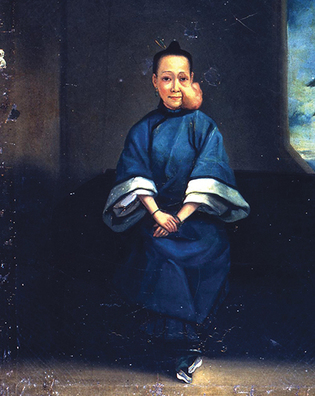 loading
loading
Arts & CultureThe art of medicineObject lesson: A nineteenth-century Yale surgeon commissioned portraits of tumor patients. Veronique Greenwood ’08 is a writer and essayist.  Yale University, Harvey Cushing/John Hay Whitney Medical LibraryLam Qua, an artist in Guangzhou, China, painted this portrait of Lo Wanshun in 1836, shortly before Peter Parker 1831, ’34MD, surgically removed the tumor from the left side of her face. The portrait is one of many such works now in Yale’s Medical Historical Library. View full image“Lo Wanshun, aged 41, of the first society in her native village, had been 20 years afflicted with a large tumour on the left side of her face.” So wrote Peter Parker, Class of 1831, ’34MD, in his notes on November 21, 1836. Just two years before, the young doctor and missionary had arrived in Guangzhou, China, known abroad as Canton, to open an eye hospital. His aims were to treat locals with modern Western medicine and to save their souls. But not long after the hospital opened, he started to receive patients like Lo Wanshun, bearing tumors of improbable size. While today such growths are removed when small, surgery was rarely practiced in China then; a tumor might expand for years. Parker took on the challenge. He also made an agreement with one of the best-known Guangzhou portraitists, Lam Qua, to capture the likenesses of his tumor patients. More than 80 of the paintings Lam Qua eventually made for Parker are now in the Medical Historical Library at Yale, where they continue to fascinate and inspire those who see them. The subjects are rich and poor, young and old, tea merchants and shoemakers: a surprising swath of Cantonese society of the time. What’s more, the images are more than just medical documents or the fund-raising tools that they became for Parker, who traveled around the world with them, lecturing to learned societies, royalty, and even the US Congress. In this painting of Lo Wanshun, Lam Qua draws upon the British portraiture style developed by Thomas Lawrence and Joshua Reynolds. The quiet features of the sitter, her voluminous robes, the moody obscurity of the room, and the fragment of landscape visible through the window behind her echo the paintings Lawrence and Reynolds made of eighteenth- and early nineteenth-century aristocracy. Scholars believe that Lam Qua learned the style from George Chinnery, an expatriate British portraitist whose flight from debts in India had brought him to nearby Macau. Beneath the edge of her robe, Lo Wanshun’s bound feet can be seen, comfortably crossed at the ankles. She is wearing the tiny slippers made specially for women whose feet had been repeatedly, painfully broken and reset into a fashionable shape while they were children, then a common practice in China. Western interest in bound feet was not always decorous: in the early 1800s, when a dead woman was found floating in the Pearl River near Guangzhou, someone cut off her bound foot and sent it as a macabre specimen to the Royal Society in London. But in this portrait, Lam Qua has shown Lo Wanshun as a person of dignity and poise. After the painting was made, the patient went under the knife. “The loss of blood was considerable; she vomited but did not faint,” Parker recorded; she was awake for the procedure, as anesthesia did not yet exist. To alleviate her fears of an ugly facial scar, Parker made a vertical incision to remove the tumor and then pulled the skin back so the scar would form behind her jawline, out of sight. After ten days, the dressings were removed and he observed that she looked close to normal. Lo Wanshun, pleased with the surgery, returned to her village and her family, and departed from the historical record, leaving only this sensitive, moving portrait behind.
The comment period has expired.
|
|